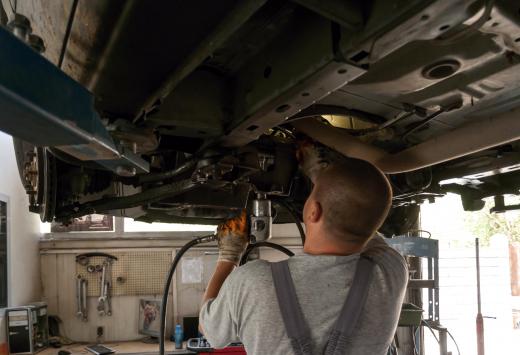A four-post hoist is a device found in many garages and automobile repair shops. It's used to raise a vehicle off the ground so that a mechanic is able to service the underneath of the vehicle. The vehicle is driven onto the ramp and the mechanic initiates the raising of the vehicle by pressing a switch that powers the hoist motor. Unlike the typical hydraulic hoist that is mounted to a single cylinder rising out of the floor, the four-post hoist uses an electric motor and cables to raise a ramp or platform. As the motor runs, it turns a spool, which winds the cable, effectively raising the ramp.
One of the benefits in using a four-post hoist is that no building construction or excavation is required to install the hoist. With the typical hydraulic-post hoist, the main hydraulic cylinder is installed beneath the garage floor, requiring significant excavation. The four-post hoist is assembled from parts, in the garage, and is typically operational in a single day. While the ramp is lifted with steel cables, the ramp and vehicle is supported by a locking mechanism that is capable of supporting the vehicle even if the cables should break. This makes the four-post hoist very safe for the worker beneath the vehicle.

One problem with the design of the four-post hoist is in the manner the vehicle is lifted. By parking the vehicle on the ramp, the tires are not removable once the vehicle is raised, making certain repairs on the hoist difficult. Many times, a vehicle must be jacked up while on the ramp and the vehicle placed on jack stands. This allows the tires to be removed while the vehicle is in the raised position on the hoist. While not an impossible operation, the added steps in jacking the vehicle before raising the hoist is often grounds to purchase a different style of hoist for some mechanics.
Another downside to the four-post hoist is the electrical lift motor. This motor requires electrical current to raise as well as lower the ramp, thereby creating a problem during power outages. With a hydraulic hoist, the pressure can be released from the hydraulic cylinder in the event of a power outage, thereby allowing the hoist to be lowered. A positive aspect of the four-post hoist is its ability to be used inside as well as outdoors. The hoist can be placed on a cement pad and used in the outside area of a garage to allow for increased repair area in any shop.
